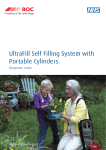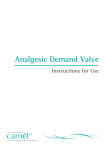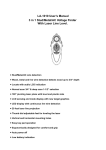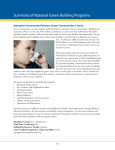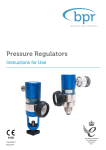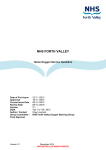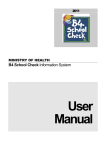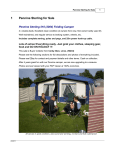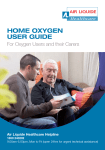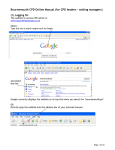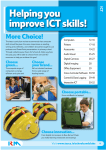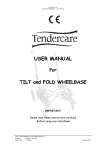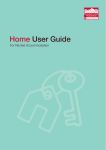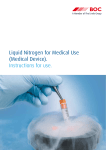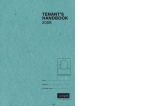Download The Home Oxygen Handbook.
Transcript
The Home Oxygen Handbook. We don’t take breathing for granted. BOC: Living Healthcare 02 The Home Oxygen Handbook Contents. 4 General safety information 6 Storage and use of equipment 7 Oils and grease 8 Transport of cylinders and portable liquid flasks 9When using your oxygen equipment please read the following safety information 10 Ordering cylinder and liquid oxygen replenishment (refills) 11 Who to notify 12 Holiday and travel 15 Data protection 17 How to tell us you have a problem 18 Support groups The Home Oxygen Handbook 03 BOC Healthcare is a member of The Linde Group; a leading supplier of medical gases globally and in the UK. Our home oxygen service provides the very best oxygen therapy products and full support at home and whilst out and about for patients of all ages with a wide variety of breathing conditions. We hope that you find it reassuring to have our equipment in your home. BOC Healthcare has been supplying oxygen for many years to people of all age groups and has built up a great deal of expertise in the area of home oxygen therapy. Please take time… to read this handbook carefully. It will help you to operate your oxygen equipment safely and ensure you get the maximum benefit from our service. We hope this handbook answers all of your questions, but if anything still troubles you then please call us on 0800 136 603. We’re here to help whenever you need us, with the right products, expert guidance and a complete range of back-up help. 04 The Home Oxygen Handbook General safety Information. Before operating your oxygen equipment, make sure that you have read the Equipment Guides for the equipment you have, and the safety instructions in this handbook. The Equipment Guides are located in the folder at the back of this handbook. If you do not have the correct instructions, then please give us a call and let us know. It is important that you refer to the section on ‘Do’s & Don’ts’ for your equipment. Pay particular attention to any information where the Hazard symbol is displayed. Do not let children tamper with your oxygen equipment or allow any untrained persons to change any controls or settings. Fire Oxygen itself does not burn – but most materials will burn very vigorously when in the presence of oxygen. It is important that the oxygen equipment is not used anywhere near where there is an open flame. Make sure that the oxygen is always used in a well ventilated area – this will ensure that you will not get any high concentrations of oxygen that will encourage things to burn. You must: →→ Never smoke (or let someone else smoke) near the oxygen equipment – even when it is being used at low flows. →→ Never use the oxygen equipment near open fires or naked flames. This includes candles on birthday cakes. We have fitted firebreaks to tubing and concentrators for your protection in the event of a fire. These are a very important safety feature and can help reduce the risk of a fire traveling down the tubing to your equipment – please do not remove them (or let anyone else remove them) from your equipment or tubing. In the event of a fire: →→ Make sure everyone is immediately evacuated from the area. →→ Immediately ring 999 – if necessary telephone from a neighbour’s house. →→ Advise the operator if there are any gas cylinders/liquid oxygen vessels in the premises. →→ As soon as it is practical ring our Patients Service Centre to advise them about the fire and let them know if any of your oxygen equipment has been involved in the fire. Do not use any oxygen equipment that has been involved in the fire. You should take any additional advice you are given by your local Fire Safety Officer. We strongly recommend that you fit a smoke alarm to your property and carry out regular checks to ensure it remains operational. The Home Oxygen Handbook 05 Firebreak. Firebreaks In the event of a fire occurring in your oxygen tubing, the firebreak will act as a thermal fuse by cutting off the oxygen supply. When the firebreak triggers, it will immediately stop the oxygen flow, preventing the flames burning back to the oxygen supply. Fire and Rescue Service (FRS) A monthly list of all patients on home oxygen therapy will be sent to the local FRS. BOC has worked very closely with the FRS to develop a working partnership to improve the safety of all our patients. At risk patients are eligible for a free visit from the community fire safety officer, which includes a discussion on fire safety and safe A firebreak is always fitted at the patient end of the exit routes in the event of a fire. tubing, just before the nasal cannula or mask. Please contact your local FRS for further information. For concentrators, a second firebreak is fitted on the outlet of the machine. If a patient is found not to have a working smoke alarm/detector in their property the local FRS will Please note: The arrow on the firebreak must be informed on a weekly basis. Patients who ignore always point towards your cannula or mask. If this fire safety advice e.g. smoking on or around oxygen is not the case, please inform BOC on 0800 136 603. therapy will also be referred to their local FRS. Firebreaks must never be removed. Please contact BOC if you need any further advice. 06 The Home Oxygen Handbook Oxygen enrichment Materials which become enriched with oxygen will burn very vigorously if they are ignited. Oxygen enrichment can occur even when the gas is used at low flow settings. →→ Never leave the oxygen supply running when it is not being used. →→ Never use or carry a portable oxygen cylinder or vessel under any clothing. You will be advised where to position the oxygen You can help to minimise oxygen enrichment by making sure the gas is used in a well ventilated area. supply system when in use – always follow these instructions. In particular, make sure that you: →→ Never place your oxygen equipment near Keep internal doors open whilst the oxygen supply is in use, this will help ventilate the room and curtains or cover them with clothing or other prevent a build up of the gas. material objects. This will restrict air circulation and increase the oxygen concentration. →→ Never put your cannula or mask on the bed or the chair whilst the oxygen supply is still turned on. Storage and use of equipment. Always follow the advice given to you about where to safely store and use your cylinders or liquid vessels and where to site your concentrator. Never leave your oxygen equipment unattended if it is switched on and not being used. Concentrators →→ Your Patients Service Representative (PSR) will advise you where to site your concentrator. Make sure that you follow their advice. →→ Your concentrator should be used in a well ventilated area, away from sources of ignition. →→ The PSR can secure your back-up cylinders to the wall to prevent them from falling over and causing an injury. This is especially important when there are young children in the house. →→ If you can not securely store your back-up cylinders upright, lay them down to ensure that they are positioned so that no one will trip over them. The Home Oxygen Handbook 07 Cylinders →→ Your PSR will advise you where to store your cylinders safely in the house. →→ Ensure that you store your oxygen cylinders in a well ventilated area, which is kept clean and dry and away from sources of heat. →→ The storage area for cylinders should not be used to store any flammable material such as paints, heating gas cylinders, oils and grease. Do not keep large quantities of combustible material (such as paper or cardboard) near your oxygen cylinder storage area. →→ Cylinders must be either stored upright or laid down to prevent them from falling over and causing an injury. This is especially important when there are young children in the house. Please note that we do not advise storing large numbers of cylinders all laid down, as this can become a hazard. →→ Consider securing the larger cylinders by using brackets screwed to the wall. Your PSR will provide you with the brackets and fit them for you. Liquid systems →→ Liquid oxygen mother unit vessels (this is the larger of the liquid units you are provided with) must always be stored upright. →→ Make sure you follow the instructions when storing your portable liquid flasks. →→ Ensure that you store and use your liquid vessel in a well ventilated area, away from sources of ignition and heat. →→ Never store your liquid unit near curtains and never cover them with any material. Oils and grease. Oils, grease and materials contaminated with these substances are particularly hazardous in the presence of oxygen. They can ignite extremely easily and will burn very violently in an oxygen enriched environment. It is important when handling your oxygen equipment to take care to ensure that it does not come into contact with any form of oil or grease. Ensure that your hands are always clean before handling the equipment. Never use oil based creams and moisturisers when using or handling the equipment. This includes: →→ Oil based lip moisturisers. →→ Oil based make up. →→ Moisturisers/barrier creams such as Sudocrem. →→ Cradle cap oils. →→ Vaseline. →→ Baby lotion. →→ Sun creams. Do not use aerosol sprays such as hair sprays or deodorants whilst using your oxygen equipment. 08 The Home Oxygen Handbook You can use alcohol gels to clean your hands – but if you do, make sure that the alcohol gel is massaged in well, particularly in between the fingers. Allow plenty of time for the alcohol gel to fully evaporate before handling your oxygen equipment. Your hands should be completely dry when handling your equipment. You may also use water based products such as RoEezit* or KY Jelly for lips and nasal passages if dry. Never use oils and grease on your oxygen equipment. Transport of cylinders and portable liquid flasks. Cylinders in cars →→ When carrying your medical cylinders or portable liquid flask in a car, we recommend that you carry a Medical Oxygen Data Sheet. This is available from your PSR or from the Patients Service Centre. →→ We recommend that you inform your motor insurance company if you intend to carry oxygen in your car. →→ Keep the car well ventilated when carrying or using the liquid oxygen flask in your car. Open a window and set the ventilation to intake air from outside to ensure the car is well ventilated. →→ Never smoke (or allow anyone else to smoke) when using or carrying oxygen in your car. * RoEezit may need to be specially ordered from a pharmacy →→ Never carry a liquid oxygen mother unit vessel (this is the larger of the liquid units you are provided with) in your car. →→ Wherever possible carry your spare cylinders securely in the boot of your car. Use a cargo net to secure the cylinders within the boot. →→ Remember to firmly secure the ambulatory cylinders or portable liquid flask in your vehicle so that they do not cause harm to persons or damage the vehicle. →→ Keep the amount of oxygen you carry in the car to a minimum. We do not recommed that you transport large, high capacity cylinders in your car. The Home Oxygen Handbook 09 When using your oxygen equipment please read the following safety information. Connecting tubing Oxygen supply Carefully connect your tubing to the oxygen supply system. Take care that any hose lying on the floor is not trapped under heavy items or allowed to kink. Ensure the tubing is not laid across the floor where it can be a tripping hazard. Only use tubing that is supplied by your Patients Service Representative (PSR). Regularly check that there is an adequate supply of gas in your oxygen equipment by checking the gauge on the cylinder valve or on the vessel. Never allow your oxygen cylinder to completely empty. Always close the cylinder valve when the oxygen supply is not in use and when the cylinder is empty. Flow rate Always use your oxygen equipment at the correct flow rate specified on your prescription. It can be dangerous to use too high or low a flowrate. All changes in flow MUST be reported to our Customer Service Centre on 0800 136 603. Check you have positioned the flow selector carefully and that the flow rate is positioned centrally in the flow rate window. You can check you have a flow by placing the end of the tube in a glass of water and watching for bubbles. Cleaning Use only a clean damp cloth to clean your oxygen equipment or any associated equipment. Only use warm water. Allow the oxygen equipment to dry after wiping down before using. Do not use any other form of cleaning agent. Repairs If your oxygen equipment develops a fault call us immediately on 0800 136 603. Never try to repair any fault unless specifically instructed by us. 10 The Home Oxygen Handbook Ordering cylinder and liquid oxygen replenishment (refills). Patients that receive all, or part, of their oxygen supply by way of cylinders (static supply, portable supply) or liquid oxygen systems, will from time to time need to order replenishment of that supply. The frequency of these replenishments will depend on the number of cylinders/liquid oxygen vessels you normally hold, and the amount you use. →→ Cylinders: We suggest you order when you start using your last cylinder – remember to order supplies for the weekend before 4pm on Thursday. →→ Liquid oxygen Mother Unit: • If your unit has an electronic gauge: Order when your mother unit is showing 2 bars. • If your unit has a manual gauge: Order when the gauge is quarter full. You should regularly check the amount of oxygen you have, so that you can order replenishment in good time to avoid running out. As orders may take a little while to process and fulfil, we would suggest ordering when you have between 3 and 5 days supply left. Orders placed will be delivered on the next working day there is no need to order on Mondays for the week ahead. You may place your order in one of two ways: 1. By telephone: call the regular helpline number 0800 136 603 Or 2. By using the “secure online” ordering facility at: www.bochomeoxygen.co.uk Important notes relating to the management of your supply: • You should not allow your cylinder/liquid oxygen supply to “run out” before ordering. Whilst BOC can respond to urgent requests, these have a significant impact on other work, including other urgent activity commitments. • If you are having difficulties managing your cylinder/liquid oxygen supplies, please discuss these with your clinician (Respiratory team, GP). • If you normally use a concentrator for all, or part of your oxygen supply, you will have been provided with back-up static cylinders for use in case of equipment failure or power cut. It is essential that these cylinders are not used as an oxygen supply for any other reason. • If, as a result of equipment failure or power cut, you have to use your back-up provisions, you must contact BOC immediately, or as soon as possible, to inform them. Important note Urgent deliveries – please plan ahead as urgent deliveries are very costly for the NHS. The Home Oxygen Handbook Who to notify. It is a wise precaution to inform your electricity supplier that you use an oxygen concentrator so that should the power supply be interrupted they are aware of your special needs. We also recommend you notify your Insurers that you have oxygen in your home. This should not affect your insurance premium but will ensure you are fully covered if you need to make a claim. Moving home or changing your telephone number Please remember to advise us if you are planning to change your address or telephone number. This is critical to ensure that we maintain regular oxygen supplies and service requirements. BOC Healthcare will inform your local fire brigade that you have oxygen in the home. This will help them in case of emergency. 11 12 The Home Oxygen Handbook Holiday and travel. Travelling with oxygen Whenever you transport oxygen cylinders in a car: If you have been supplied a Marathon unit: It is advisable to take a Medical Oxygen Data Sheet. Lay the unit down horizontally, flat side down to This is available from your PSR. ensure it does not tip over as shown in the picture on the next page. We do not recommend you display stickers on the car window as this can give misleading information If you have been supplied a Companion unit: Keep the unit upright AT ALL TIMES to prevent to the emergency services. spillage of liquid oxygen. The unit must be securely Please do advise your car insurer that you may be fastened in an upright position for transporting, transporting a small number of cylinders or liquid as shown in the picture on the next page. oxygen in your vehicle. Please do not attempt to transport the liquid mother unit at any time. Remember to firmly secure the ambulatory cylinders in your vehicle so that they do not cause harm to persons or damage the vehicle. We recommend that you notify your insurance company that you intend to transport oxygen Wherever possible locate any spare cylinders in the therapy equipment so that it is covered should it be damaged in transit. Your insurance is not boot or away from the vehicle cabin. We do not recommend that patients transport high compromised by transporting oxygen in gas or liquid form. capacity cylinders. If transporting a concentrator: The machine must be in an upright position and must be securely restrained within the vehicle to avoid injury should the vehicle be involved in an accident. Do not lay it flat in the boot of the car as it can internally damage the machine. It would be much safer to discuss movement of any concentrator with the Patients Service Centre. The concentrator does not produce oxygen while it is switched off and therefore is not hazardous. When transporting liquid portable oxygen vessels: First identify the unit you have been supplied using the Equipment Guide for liquid systems. Holiday oxygen The Home Oxygen Handbook Transportation of a Companion portable liquid flask. Even if you have a condition which requires oxygen therapy, you may wish to go on holiday either within the UK or abroad. We have put together some key considerations for you if you wish to go on holiday. We can help with many of the details and offer advice. Please give us at least 3 working day’s notice of your holiday requirements, however it is best to request as early as possible. Please contact us on 0800 136 603, giving us plenty of warning so that we can help you as much as possible. Going on holiday in the UK Before you book →→ Contact your planned holiday destination to gain permission for oxygen equipment to be delivered and stored in the accommodation. →→ If you are travelling by public transport – contact the transport company and inform them you will be carrying oxygen. →→ There is no need for a holiday HOOF, please contact BOC on 0800 136 603 to discuss your holiday plans and we will send the details to 13 Transportation of a Marathon portable liquid flask. the oxygen provider covering the area you are travelling to. BOC will need the following information: 1. Start and end date of your holiday 2. Full postal address and telephone number of the holiday destination. If your prescription should change please call BOC on 0800 136 603 to discuss. →→ Please talk to your Patients Service Representative (PSR) or call us to discuss on 0800 136 603. →→ We do not advise any patients to transport static concentrators or non portable cylinders. Holidays outside the UK (including the Channel Islands) Before booking a holiday outside the UK it is advisable to discuss your plans with your doctor or healthcare professional – especially if you are flying. During a flight, the high altitudes will cause the oxygen concentration levels in the air in the cabin to fall. People without the need for supplementary 14 The Home Oxygen Handbook oxygen are largely unaffected – however it could have serious implications for people who require oxygen therapy under normal circumstances. Your doctor or healthcare professional may decide to increase your flow rate during your flight. Before you book your flight find out the following information: →→ What the airline’s policy is on oxygen. Taking oxygen on a plane can be easy and free, or difficult and expensive. Some airlines will not allow oxygen on the plane at all, it depends on the airline. You must find out before you book a ticket. This may also affect your choice of destination or carrier. →→ The exact length of the flight, and whether delays are likely. →→ The facilities available at both airports. This includes assistance required with luggage, boarding the aircraft, wheelchair requirements and whether oxygen is available. If the holiday involves a long-haul flight, you should find out if time will be spent at a third airport for refuelling and how oxygen will be supplied there if required. With the exception of oxygen provision, these services will usually be free. →→ How you confirm your fitness to fly. Some airlines let you travel without a letter from your doctor, while others ask you to fill in a special medical form, verified either by your own GP or by the airline’s medical staff. Most ask for a fitness to fly certificate, obtained from your doctor. Insurance Everyone who is resident in the UK should have insurance and carry it with them when travelling abroad. Remember to check your EHIC (European Health Insurance Card) is still valid before you travel. Applying for the card is free and it’s valid for up to five years. Your EHIC will allow you access to the same state provided healthcare as a resident of the country you are visiting. However, many countries expect the patient to pay towards their treatment, and even with an EHIC, you might be expected to do the same. You may be able to seek reimbursement for this cost when you are back in the UK if you are not able to do so in the other country. The EHIC is NOT an alternative to travel insurance. It will not cover any private medical healthcare or the cost of things such as repatriation to the UK or lost or stolen property. For these reasons it is important to have both an EHIC and a valid private travel insurance policy. Some insurers now insist you hold an EHIC and many will waive the excess if you have one. You can apply for an EHIC by picking up a form at your post office or online at www.ehic.uk.com. If you are travelling outside the European Union, please speak to your Travel Advisor about the country’s specific requirements. The British Lung Foundation has some useful information on their website www.lunguk.org. Alternatively contact them on 0845 8505020. The holiday equipment you may receive whilst you are holiday may differ slightly from the equipment you use at home – if you experience any difficulties you will be given a telephone number for the provider where you are holidaying. Remember the same safety precautions apply on holiday as they do when you are at home. The Home Oxygen Handbook 15 Data protection. You will appreciate that in order to provide our oxygen service we need to hold important personal data about your oxygen needs. This information will be held securely within our database only for as long as we need it. We will only disclose this information to those health care professionals who are involved in your care or in the administration of your care. You have a right under the Data Protection Act (DPA) to see the personal data that we hold and process. Should you wish to do this then please contact: Data Protection Officer BOC Healthcare Priestley Road Worsley Manchester M28 2UT Following the installation of your oxygen equipment, we will ask you to sign the statement on the following page if you are happy to do so. Patient declaration This statement should be read following the installation of oxygen equipment. By signing the electronic PODD (this is a hand held device used by our PSRs to facilitate installations and deliveries of oxygen equipment to patients. This feeds back directly into our computerized system and is recorded on individual patient‘s records) device, which the PSR has, and the risk assessment form you are confirming your understanding and agreeing to the contents of this statement. I am aware that BOC Healthcare is collecting and processing my personal data, including details of my GP and my oxygen prescription, to ensure that the correct equipment is provided. My details will be held securely in accordance with the Data Protection Act. I understand that in order to provide an effective and safe service it may be necessary to pass my details to other professionals directly involved in the provision of my healthcare. This may involve passing my personal data to the Fire Service for them to place on their at risk registers to ensure that they are aware of the oxygen risk at the premises in the event of a fire. If I have an oxygen concentrator installed this may also involve registering my address on my electricity provider’s “at risk” register to enable notification and prioritisation in the event of loss of power to my area. Please note: personal information will not be passed to others who do not have a legitimate interest in your well being. I am aware that telephone calls to and from BOC Healthcare may be recorded for training purposes and that I may, on occasion, be selected at random 16 The Home Oxygen Handbook to be visited by the Audit Compliance Manager to confirm that the oxygen installation at my premises has been completed to the appropriate standards by the Patients Services Representative. I confirm I have been trained in the safe use of the oxygen equipment provided and have received patient safety literature. I confirm that I accept responsibility to keep the oxygen equipment in a safe condition as instructed by the supplier. I am aware that any items fitted to the oxygen supply equipment or within tubing are an integral part and may not be removed. I understand that the oxygen installation must not be altered without prior consultation with and agreement from BOC Healthcare. I understand that oxygen equipment must be used and stored in well ventilated areas, and not near any sources of oil, grease, paints, solvents or any other flammable material. I understand that oxygen equipment must not be used or stored within 10 feet (3 metres) of portable paraffin heaters or any appliances with an open flame e.g. gas fires and cookers. Oxygen equipment must not be used and stored within 5 feet (1.5 metres) of electrical appliances e.g. televisions, hairdryers, air conditioning units or heating appliances with no naked flame. I am aware that smoking is strictly prohibited in the vicinity where the oxygen is used or stored. I can confirm the oxygen equipment has been installed to my satisfaction. The Home Oxygen Handbook How to tell us you have a problem. Our aim is to provide you with a safe, friendly and reliable service. If you have any problems with the service please tell us immediately. If you would like to make a complaint about the service, please call us on our freephone helpline number on 0800 136 603 and one of our Patients Service Advisors will be able to assist you. If you prefer, you can also make your complaint in writing to: BOC Healthcare Patients Service Centre Priestley Road Worsley Manchester M28 2UT Or by email: [email protected] BOC will aim to resolve your complaint as quickly as possible within timescales we have discussed and agreed with you. If your complaint is not resolved by us If BOC does not resolve your complaint to your satisfaction, you may wish to speak to your Local Health Authority. They are responsible for managing the performance of the Home Oxygen Service providers and will be able to help and advise you with what you will need to do next. 17 18 The Home Oxygen Handbook Support groups. www.need2know.co.uk Information site for teenagers www.teenagehealthfreak.org Teenage friendly health advice www.lunguk.org British Lung Foundation www.CHfed.org.uk The Childrens Heart Federation www.CAfamily.org.uk Contact a family charity for families with disabled children www.newlifecharity.co.uk Foundation for disabled children www.wellchild.org.uk Helping sick children and their families www.parentsforinclusion.org Support site for parents with disabled children www.cftrust.org.uk Cystic Fibrosis Trust www.everychildmatters.gov.uk/earlyyears/ earlysupport Support services for disabled children www.hearts4teens.org.uk Support for teenagers with heart defects www.skill.org.uk National bureau for students with disabilities The Home Oxygen Handbook Free NHS smoking helpline Fire and Rescue Services Call to speak to a trained expert adviser for free on 0800 169 0 169. Now you’re benefiting from oxygen therapy in your home, you need to make sure you follow a few basic tips to help you keep safe from fire, such as never smoking (or letting anyone else smoke in the same room as you) while you use your oxygen equipment. For more tips, please visit www.direct.gov.uk/firekills Lines are open every day from 7 am – 11pm. Or visit their website www.nhs.uk/smokefree Alternatively, for advice and support regarding smoking cessation, talk to your GP or nurse. 19 Did you know your local fire and rescue service offers a free Home Fire Risk Check? This is where an operational team will come to your home to identify and help reduce potential fire risks, and help you plan an escape route in case a fire should break out; they may also install a free smoke alarm. You can find the phone number for your local fire and rescue service in your local phone book or from www.direct.gov.uk/firekills where you can also find more information on how to protect you and your home from fire. If you are visually impaired and require a large print copy, please contact us. Contact us. BOC Healthcare Patients Service Centre, Priestley Road, Worsley, Manchester M28 2UT, United Kingdom Tel 0800 136 603, Fax 0800 169 9989, [email protected], www.bochealthcare.co.uk The stripe symbol and the letters BOC are registered trade marks of The BOC Group Limited. Both BOC Limited and The BOC Group Limited are members of The Linde Group, the parent company of which is Linde AG. Reproduction without permission is strictly prohibited. © BOC Limited 2012 HLC/406900/0811 Our normal working hours are Monday to Friday 8am until 5.30 pm. We are open 24 hours for emergencies only.




















